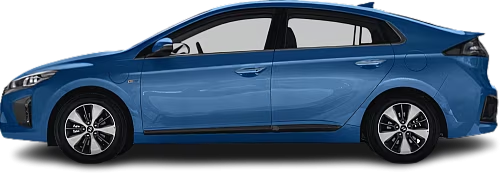Mercedes EQE SUV 350 4MATIC vs Hyundai Ioniq Electric Gen 1
Struggling to Decide? Let AI Help!
Your AI Summary Is Ready!
General Info
The Mercedes EQE SUV 350 4MATIC (2022-…) is currently produced, it has a starting price of $77900. The Hyundai Ioniq Electric Gen 1 (2016-2019) has been discontinued. You can find it for as low as $8700 on the used car market.
The Mercedes EQE SUV 350 4MATIC (2022-…) is a SUV, whereas the Hyundai Ioniq Electric Gen 1 (2016-2019) is a Liftback.
| Property | Mercedes EQE SUV 350 4MATIC | Hyundai Ioniq Electric Gen 1 |
|---|---|---|
| Years of Production | 2022-… | 2016-2019 |
| Current Status | Produced | Discontinued |
| Country of Manufacture | USA, China | South Korea |
| Body Style | SUV | Liftback |
| Market Availability | EU, USA | EU, USA |
| Price USA (New) | $77900 | - Price USA (New) |
| Price USA (Used) | $35260 | $8700 |
| GCC Score | 6.7 | 4.8 |
Range and Efficiency
While the Mercedes EQE SUV 350 4MATIC (2022-…) offers a longer real-world range and a bigger battery, it is less energy-efficient than the Hyundai Ioniq Electric Gen 1 (2016-2019).
| Property | Mercedes EQE SUV 350 4MATIC | Hyundai Ioniq Electric Gen 1 |
|---|---|---|
| Range (EPA) | 265 mi | 124 mi |
| Range (WLTP) | 352 mi | - Range (WLTP) |
| Range (GCC) | 273 mi | 124 mi |
| Battery Capacity (Nominal) | 100 kWh | 30.5 kWh |
| Battery Capacity (Usable) | 90.6 kWh | 28 kWh |
| Efficiency per 100 mi | 33.2 kWh/100 mi | 22.6 kWh/100 mi |
| Efficiency per kWh | 3.01 mi/kWh | 4.43 mi/kWh |
| Range and Efficiency Score | 6.5 | 6.2 |
Charging
Both vehicles utilize a standard 400-volt architecture.
The Mercedes EQE SUV 350 4MATIC (2022-…) offers faster charging speeds at DC stations, reaching up to 170 kW, while the Hyundai Ioniq Electric Gen 1 (2016-2019) maxes out at 69 kW.
The Mercedes EQE SUV 350 4MATIC (2022-…) features a more powerful on-board charger, supporting a maximum AC charging power of 9.6 kW, whereas the Hyundai Ioniq Electric Gen 1 (2016-2019) is limited to 6.6 kW.
| Property | Mercedes EQE SUV 350 4MATIC | Hyundai Ioniq Electric Gen 1 |
|---|---|---|
| Max Charging Power (AC) | 9.6 kW | 6.6 kW |
| Max Charging Power (DC) | 170 kW | 69 kW |
| Architecture | 400 V | 400 V |
| Charge Port | CCS Type 1 | CCS Type 1 |
| Charging Score | 6.6 | 3.5 |
Performance
The Hyundai Ioniq Electric Gen 1 (2016-2019) is front-wheel drive, while the Mercedes EQE SUV 350 4MATIC (2022-…) offers an all-wheel drive system.
The Mercedes EQE SUV 350 4MATIC (2022-…) boasts greater motor power and accelerates faster from 0 to 60 mph.
| Property | Mercedes EQE SUV 350 4MATIC | Hyundai Ioniq Electric Gen 1 |
|---|---|---|
| Drive Type | AWD | FWD |
| Motor Type | PMSM (front), PMSM (rear) | PMSM |
| Motor Power (kW) | 215 kW | 88 kW |
| Motor Power (hp) | 288 hp | 118 hp |
| Motor Torque | 564 lb-ft | 218 lb-ft |
| 0-60 mph | 6.2 s | 9.5 s |
| Top Speed | 130 mph | 103 mph |
| Performance Score | 5.5 | 2.9 |
Dimensions
The Mercedes EQE SUV 350 4MATIC (2022-…) is longer, wider, and taller.
The Mercedes EQE SUV 350 4MATIC (2022-…) boasts a more extended wheelbase.
| Property | Mercedes EQE SUV 350 4MATIC | Hyundai Ioniq Electric Gen 1 |
|---|---|---|
| Length | 191.5 in | 176 in |
| Width (with Mirrors) | 84.3 in | 80.5 in |
| Width (w/o Mirrors) | 76.4 in | 71.7 in |
| Height | 66.3 in | 57.1 in |
| Wheelbase | 119.3 in | 106.3 in |
Cargo and Towing
The Mercedes EQE SUV 350 4MATIC (2022-…) provides more cargo capacity, featuring both a larger trunk and more space with the rear seats folded.
Neither car is equipped with a frunk (front trunk).
The Mercedes EQE SUV 350 4MATIC (2022-…) has a towing capacity of up to 3500 lb, whereas the Hyundai Ioniq Electric Gen 1 (2016-2019) is not officially rated for towing in the US.
| Property | Mercedes EQE SUV 350 4MATIC | Hyundai Ioniq Electric Gen 1 |
|---|---|---|
| Number of Seats | 5 | 5 |
| Curb Weight | 5576 lb | 3131 lb |
| Cargo Volume (Trunk) | 18.4 ft3 | 12.4 ft3 |
| Cargo Volume (Max) | 59.2 ft3 | 49.8 ft3 |
| Cargo Volume (Frunk) | - Cargo Volume (Frunk) | - Cargo Volume (Frunk) |
| Towing Capacity | 3500 lb | - Towing Capacity |
| Cargo and Towing Score | 7.8 | 4.2 |




